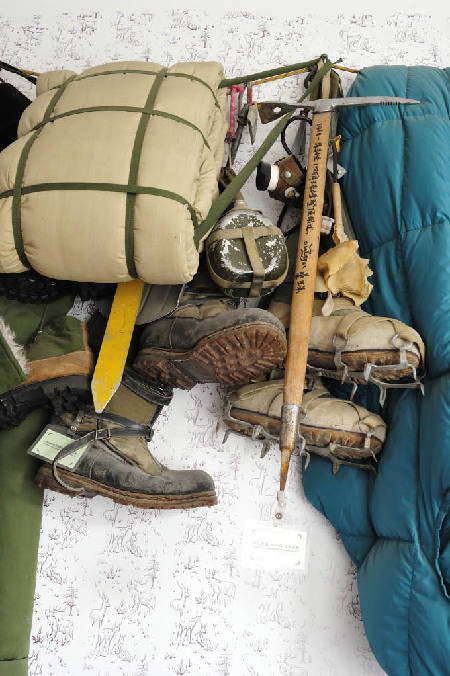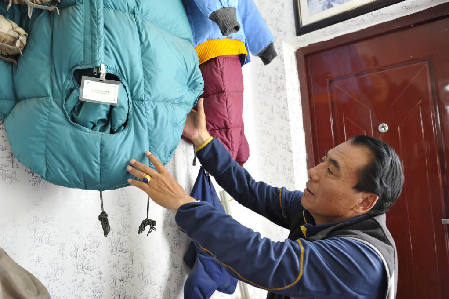Samdrup’s Mountaineering Gear – an Evolutionary History
SAMDRUP is the ex-captain of the Tibetan Mountaineering Team. The hallway in his home exhibits a miniature mountaineering museum. Along its walls hangs all the mountaineering equipment he has used since 1974. From basic to advanced, this gear chronicles the progress and development of mountaineering in Tibet, and in China as a whole.
 |
| Mountaineering equipment from the 1970s. |
Advent of Mountaineering 41 Years Ago
Born in 1952, Samdrup has risen up through the ranks from a 17-year-old army recruit in Biru County, Nagqu Prefecture in northern Tibet. At that time, he never imagined that his life-track would intersect with mountain climbing. But then in January 1974, China’s National Mountaineering Team came to Biru County to recruit team members to climb Mount Qomolangma. After rounds of physical examinations and fitness tests, Samdrup and 30-odd other locals were selected and trucked off to Lhasa.
In the western suburbs of Lhasa, the approximately 400 candidates selected from various regions of Tibet lived in a row of sheet-iron bungalows. During the two-month strength-training course, every member underwent physical and mental check-ups. Those found not up to snuff were culled. Ultimately, only 100-odd people remained, among them Samdrup.
Their intimate contact with Qomolangma finally came. In late March 1974, the 100 team members chosen deployed to the 5,200-meter base camp for acclimatization training. From there, they started to climb, step-by-step, 5,400 meters, 5,800 meters, 6,000 meters – with their campsites strung out behind them along the way. All members arrived at the 7,028-meter altitude camp, staying there for the next two nights as the coach monitored the condition of each. Samdrup did not suffer altitude sickness or headaches at that altitude, and actually found he had an even better appetite. He became shortlisted for the Qomolangma climb.
In August that year, his team came to Beijing to intensify their physical training. When not eating and sleeping, he spent all his time hiking up and down hills by way of weight training, toting more than 40 kg of sand for maximum exercise effect. After training, he fell asleep as soon as his head hit the pillow. Some teammates even vomited from exhaustion and were unable to keep their food down. This kind of training lasted from summer until winter.
What struck Samdrup most was that, in the interests of economy, these novices received no new equipment, but wore and used exclusively second-hand items issued to senior team members in their 1960 ascent of Qomolangma. “The duck down climbing wear I drew had been patched all over, the hiking boots were tattered and shabby, and my sleeping bag also shed, so my head was all white with feathers in the morning,” he said. The team kept using this old gear until starting the formal climb in 1975.
 |
| The China-made duck down sleeping bag that Samdrup used in 1975. |
Reaching the Peak with Home Equipment in 1975
According to Samdrup, the 1975 climb was of vital importance. “Our team was made up of male and female members, both Tibetan and Han. This was a golden opportunity to showcase the strength of the Chinese mountaineering team and the unity of the Chinese nation to the international community,” he said.
In the then political environment, mountaineering had ranged far beyond the scope of pure sports to become an act of projecting national power. Although China was still gripped by the catastrophic “cultural revolution,” the State Council nevertheless appropriated special funds for gear and materials for the climb.
“At that time, much equipment was unavailable in China, even oxygen cylinders were not domestically produced,” he said. Many of their facilities, such as oxygen cylinders, mountaineering ropes and gas tanks used at an altitude of over 8,000 meters were all imported from France and the former Soviet Union, nations with well-developed traditions of alpinism. “Imported oxygen cylinders were quite rare, and could only be used in life-threatening situations.” Samdrup’s five-member team was issued with only one bottle of oxygen.
Food and clothing for the climb were all of domestic manufacture. “The down-filled coat made in Shanghai was good for keeping warm, but too bulky when worn.” Samdrup jokes that he looked like a chubby panda in it 40 years ago. Climbing boots filled with duck’s down weighed more than three kilos after being fitted with crampons. The down-feather mittens were also ungainly, but without them frostbite was inevitable.
Samdrup brightened up when recalling the food they consumed: in addition to compressed biscuits and canned meat, they enjoyed white chocolate specially produced for the 1975 Qomolangma climb. “In China at that time only we could enjoy this kind of chocolate. It was both delicious and good for boosting energy,” he said. Canned fruits, such as oranges, pineapples and pears, were preserved in glass jars, which smashed easily. “We had to eat the fruit quickly. It would have been a pity to waste even the juice.”
Conquer 14 Peaks in 14 Years
On May 27, 1975, Samdrup and his other eight teammates succeeded in mounting the crest of Qomolangma. This heroic undertaking inscribed an indelible entry into the annals of world mountaineering, and has been the most meaningful and proudest experience in Samdrup’s life. Since then, he has joined in various mountaineering expeditions with the team.
In 1993, an expedition set off to climb 14 peaks topping 8,000 meters worldwide. As its captain, Samdrup inaugurated yet another protracted expedition. The 10-member team spent 14 years until achieving this magnificent feat in 2007.
Samdrup likens the upgrades in mountaineering equipment in recent years to “exchanging fowling pieces for cannon.” Various lightweight outdoor outfits used in his recent climbs adorn his hallway wall. From basic to advanced, this equipment records the progress and development of mountaineering in Tibet, and China as whole. The changes in this gear thus narrate his mountaineering experiences.
Spreading Popularity
Among the 8,000-plus meter peaks Samdrup has conquered, five lie in Tibet. The autonomous region also has an additional 70-odd peaks with an altitude of over 7,000 meters, and thousands more over 6,000 meters high. These advantageous peak resources set ideal preconditions for the rapid development of Tibet’s mountaineering industry.
Along with China’s opening-up and the widespread growth of alpinism, mountaineering in Tibet is now going from strength to strength. Especially in recent years, mountain-climbing has gradually changed from an extremely challenging human exertion to an economic vehicle serving the socio-economic weal. The mountaineering industry has thus become a new bright spot in Tibet’s economic development.
Statistics from the local sports administration indicate that, from 1980 to 2014, Tibet attracted 17,248 climbers in 1,679 teams, thereby generating monetary income of over RMB 320 million. Moreover, extensive international mountaineering also helps local farmers and herdsmen increase their incomes. The year 2014 alone saw more than RMB 3 million allocated to mountaineering support, guide services and environmental fees.
According to the Tibet Mountaineering Association, from 2000 to 2010, Tibet hosted some 30,000 mountaineering aficionados of 600 teams from 40 countries and regions, generating income of RMB 48 million.
The huge need for individual mountaineering has given birth to a dependent service industry. Founded in 1999, the Tibet Mountaineering School is committed to cultivating professional mountain guides and service staff. Every two years, the school selects about 20 16-year-old students with climbing potential from Xigaze City. Thus far, the school has trained over 300 skilled guides who understand foreign languages.
The school’s founder, Nima Tsering, opened a Himalayan expedition service company in 2001 to offer job opportunities to most of these graduates. During the busy season, a powerful team activates on the north side of the Himalayas. The company has helped hundreds of domestic mountaineers realize their dreams of conquering peaks over 8,000 meters high.
Along with the growing number of climbers from home and abroad, Tibet has also ramped up efforts to popularize amateur mountaineering, with mountaineering conferences held each spring and autumn. In addition, the Yangpachen Mountain Training Base and the Himalayan Mountaineering Museum have also sprung up. Tibet is enabling more daredevils to discover its unique charm via its booming mountaineering industry on this snow-dappled plateau.
In Samdrup’s view, mountaineering transcends mere physical exercise. For him, scaling to an altitude unattainable by ordinary folk is to bear along with him the expectations, and the honor and glory of the entire Chinese nation.
